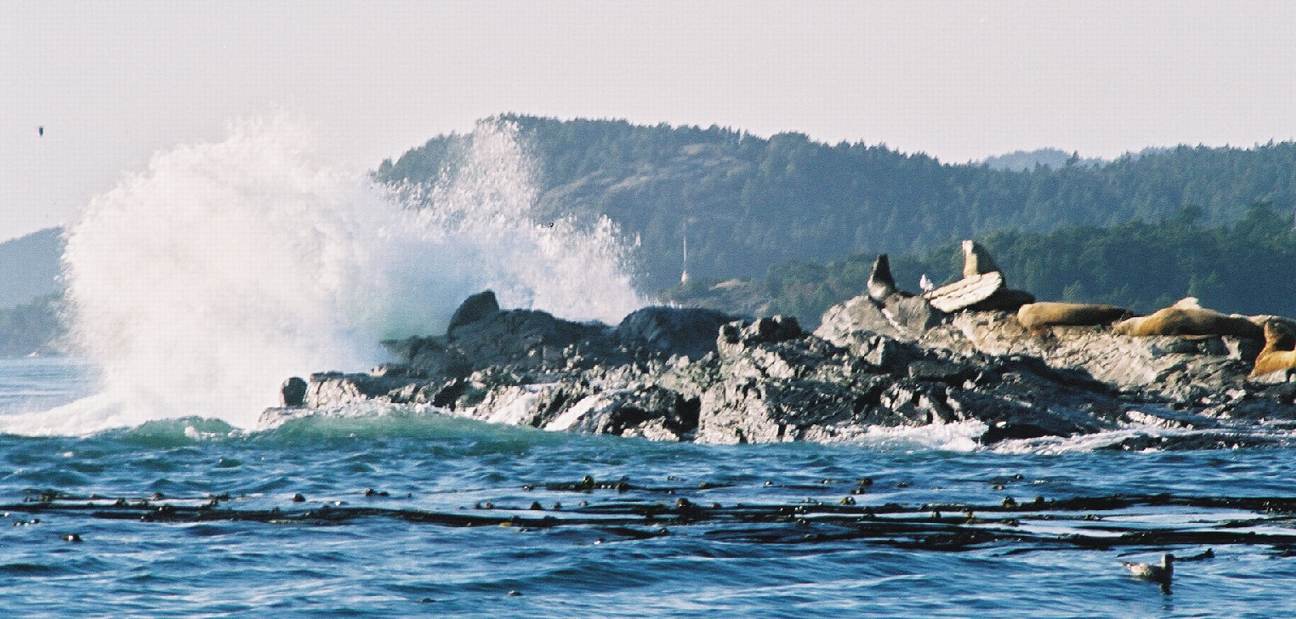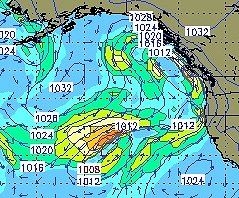
Here at North Rocks, the surge can send columns of water up several metres as the swells break on the island which is the first shallow mound that long wave energy encounters as they come up the Strait of Juan de Fuca.
See the posts in this log referring to SWELL:
The location of the Race Rocks Archipelago at the Eastern entrance of the Strait of Juan de Fuca means that the water column is particularly influenced by events which occur far out to sea in the North Pacific Ocean. Storms in the Pacific impart energy to the water column which eventually ends up in the Strait of Juan de Fuca and then on the shores of Race Rocks. Scenes like that above are typical. Of course this energy is originally solar derived.
The water was calm but storms occurring the day before still sent energy shoreward that piled up against the shore and broke as surf. The implications for organisms living in this zone are varied. Only those with sturdy attachments can survive and many algae and diatoms are allowed to grow well above the highest tide level. Goose neck barnacles thrive as this energy brings in their planktonic food. This action is not constant. A set of swells may be followed by 5 minutes of calm shores and then it starts again. The video below shows the surge channel closeup from this same area.
On a field trip to Race Rocks with the Biology class in the spring 2003, we took some time to observe and video the surge channel out on the south-west tip of Great Race Rock. It was a calm day which had been preceded by a few days with storms out in the Pacific Ocean.
The energy imparted to the water column was just now reaching Great Race and the water was breaking on the west shore. The effect of “surge” as an abiotic factor in the distribution of organisms on shore is not often considered in affecting the intertidal zonation of organisms on rocky coastlines in marine biological research. It is clear that here, that the elevation up the shoreline in the intertidal zone where many invertebrates and algae can survive isincreased. These intertidal organisms are able to keep moistened longer, ambient temperatures are depressed from evaporation and and they even have longer availability to food resources being carried in the surging water. This is most obvious with the goose neck barnacle population and the intertidal anemone distribution along this shore. Additionally the tidepools up the channel are flooded more frequently, resulting in lower temperatures and more stabilized salinity conditions. It should be emphasized that this is not directly “wind-driven” water movement. As one can see in the video below, the surrounding sea is calm, with little wind that day.The effect on intertidal organisms on Race Rocks is significant.
On the west side of Great Race Island in particular, the intertidal zonation of algae and invertebrates is directly influenced by the level and frequency of swell or surge.The videos above give an idea of how these swells come ashore on the island.
| To get an idea of what the sea state is off our shore that causes the swells that break on Race Rocks, go to the buoy locations from the National Buoy Data Center Note in particular the data from our closest marine buoy stations:
Buoy #TT1W1Tatoosh Island , WA.Longitude = 124.74W Latitude = 48.39N and
|

